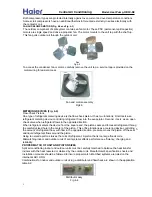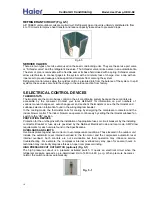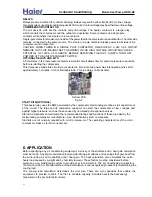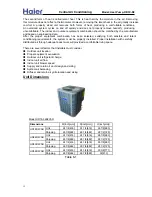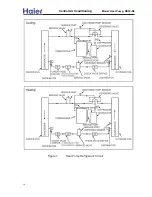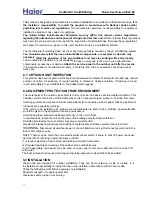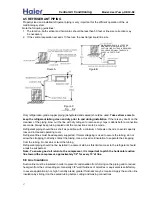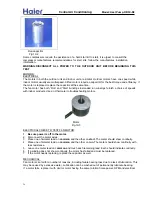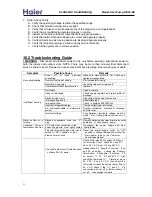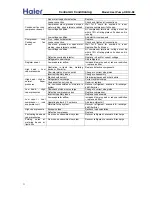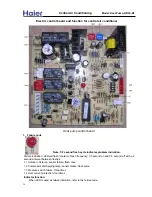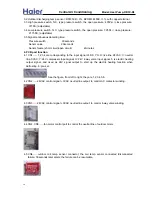
9.MAINTENANCE INSTRUCTIONS
FILTERS
WARNING: DISCONNECT MAIN ELECTRICAL POWER TO THE UNIT BEFORE ATTEMPTING ANY
1.
attention until dust and fibers from the
construction is removed.
2. Replace glass fiber filters when dirty.
3. Clean semi-permanent plastic impregnated fiber filters :
Caution: Do not operate any system without filters
Note:
if an electronic air cleaner is installed, remove any mechanical filter from the air handler. Follow
the
installation and
maintenance instructions furnished with the electronic cleaner.
OUTDOOR COIL CLEANING
shrubs, or other obstructions at least 24” away from the coil air inlets.
B. Remove the top with the outdoor fan attached.
C. Flush water through the coil from the inside out.
NOTE:
Avoid getting
water on any controls or other electrical devices. If electrical
components
get
wet, dry it thoroughly before energizing.
There are
many
commercial coil cleaning
materials developed to clean outddor coils
. Follow the
manufacturer's instructions when using these marterials.
Normally the solvent is sprayed onto the coil.
Allow several minutes for the solvent to dissolve any
organic matter .Wash away the solvent and
any
dissolved
matter with water from a garden hose.
NEVER USE A WEATHER COVER OVER THE OUTDOOR UNIT
. The unit is designed to operate
outdoors. A cover traps moisture in the unit causing rust and corrosion .There is the added danger of
starting the system with the cover on. This prevent air flow through the outdoor coil causing dangerous
system pressure .Compressor damage
may
result.
The air conditioning system operates must efficiently with clean air filters, check filters monthly to
determine how frequently your filters need be cleaned.
A new home require more frequent filter
Keep the outdoor coil clean for full air flow and proper operation .Do not allow leaves, grass
If the coil becomes obstructed or dirty, it may be necessary to clean the coil.
clippings or other material to obstruct the coil. Do not allow anything to block the coil. Keep fences,
A. Before cleaning coil,
TURN OFF ELECTRICAL POWER
to the outdoor unit.
SERVICE OR MAINTENANCE.
A. Vacuum clean; or B: Wash with detergent and water, air dry thoroughly and re-install.
10. SERVICE AND TROUBLESHOOTING
WARNING
:
THE ABILITY TO PROPERLY PERFORM SERVICE ON THIS EQUIPMENT REQUIRES
EXPERIENCE
,
MECHANICAL SKILLS
,
TOOLS AND TEST EQUIPMENT .IF YOU
ARE
NOT
QUALIFIED,
DO NOT ATTEMPT TO PERFORM ANY
SERVICE
ON THIS EQUIPMENT
, CONSULT THE USER'S
MANUAL
FOR ROOTING MAINTENANCE THAT CAN BE DONE BY THE HOME OWNER
.
FAILURE TO FOLLOW THIS WARNING COULD RESULT IN POSSIBLE DAMAGE TO THE
EQUIPMENT, SERIOUS PERSONAL INJURY,
OR DEATH.
The HVAC industry
, had improved the
efficiency
of the products offered to consumers. New and
more
sophisticated mechanical
and electronic features
for achieving higher efficiencies have been
design
ed. The use of test equipment is now more critical than ever.
In the servicing and troubleshooting section is information on compressors and other components and
their test procedures. There are troubleshooting charts, charging charts, wiring diagrams and service
guide
charts. Included is list of suggested test equipment.
T
his information
can be uesed by the service technician
to understand the installation
and troubleshooting
and operation of the
current familie of air conditioning. The procedures in this section are
generic in content.
Each product family incorporates some of these components.
Be aware of this is a guide compiled from
numerous sources. It can not take into consideration all conditions found in all installations.
Note:
Upon arrival at the job site,
a sound first step is a review of the system installation to identify any
obvioss problems, this
Installation Manual should be used as a guide.
REFRIGERANT RECOVERY
Refrigerant systems using chlorofluorocarbon (CFC) and Hydrochlorofluorocarbon (HCFC) refrigerants
system are subject regulation by
the clean air Act of 1990.
This act prohibits the
unrestricted release
23
Central Air Conditi
oning
Model: Heat Pump,
HR13-D2

